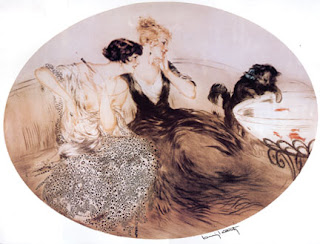His childhood was in Toulouse:
....The Icart family lived modestly in a small brick home on rue Traversière-de-la-balance, in the culturally rich Southern French city of Toulouse, ....
On a visit to relatives in Paris, his aunt, who owned a fashionable millinery shop, saw the young Louis’ work and encouraged him to move to Paris to pursue his art. He did so in 1907 and started his career in a studio that produced erotic postcards of the type for which Paris was then famous. His first job was to make copies of existing images but he soon began designing original works....
It was during this period that Icart learned the technique of etching on copper, an art form which he pushed to new heights. He combined his love of fashion and beautiful women with an equally clear appreciation of his commercial value as an artist and rapidly achieved success as an illustrator of catalogues for fashion houses. In 1913 he was invited to exhibit at the Salon des Humoristes.....
...He worked for major design studios at a time when fashion was undergoing a radical change-from the fussiness of the late nineteenth century to the simple, clingy lines of the early twentieth century
...
Art Deco, a term coined at the 1925 Paris Exposition des Arts Decoratifs, had taken its grip on the Paris of the 1920s. By the late 1920s Icart, working for both publications and major fashion and design studios, had become very successful, both artistically and financially. His etchings reached their height of brilliance in this era of Art Deco, and Icart had become the symbol of the epoch. Yet, although Icart has created for us a picture of Paris and New York life in the 1920s and 1930s, he worked in his own style, derived principally from the study of eighteenth-century French masters such as Jean Antoine Watteau, François Boucher and Jean Honoré Fragonard..... In fact, Icart lived outside the fashionable artistic movements of the time and was not completely sympathetic to contemporary art.
Icart's portrayal of women is usually sensuous, often erotic, yet always imbued [with] an element of humor...
It was during this period that Icart learned the technique of etching on copper, an art form which he pushed to new heights. He combined his love of fashion and beautiful women with an equally clear appreciation of his commercial value as an artist and rapidly achieved success as an illustrator of catalogues for fashion houses. In 1913 he was invited to exhibit at the Salon des Humoristes.....
...He worked for major design studios at a time when fashion was undergoing a radical change-from the fussiness of the late nineteenth century to the simple, clingy lines of the early twentieth century
...
Art Deco, a term coined at the 1925 Paris Exposition des Arts Decoratifs, had taken its grip on the Paris of the 1920s. By the late 1920s Icart, working for both publications and major fashion and design studios, had become very successful, both artistically and financially. His etchings reached their height of brilliance in this era of Art Deco, and Icart had become the symbol of the epoch. Yet, although Icart has created for us a picture of Paris and New York life in the 1920s and 1930s, he worked in his own style, derived principally from the study of eighteenth-century French masters such as Jean Antoine Watteau, François Boucher and Jean Honoré Fragonard..... In fact, Icart lived outside the fashionable artistic movements of the time and was not completely sympathetic to contemporary art.
Icart's portrayal of women is usually sensuous, often erotic, yet always imbued [with] an element of humor...
Louis Icart died quietly in his sleep at his Montmartre home...

No comments:
Post a Comment